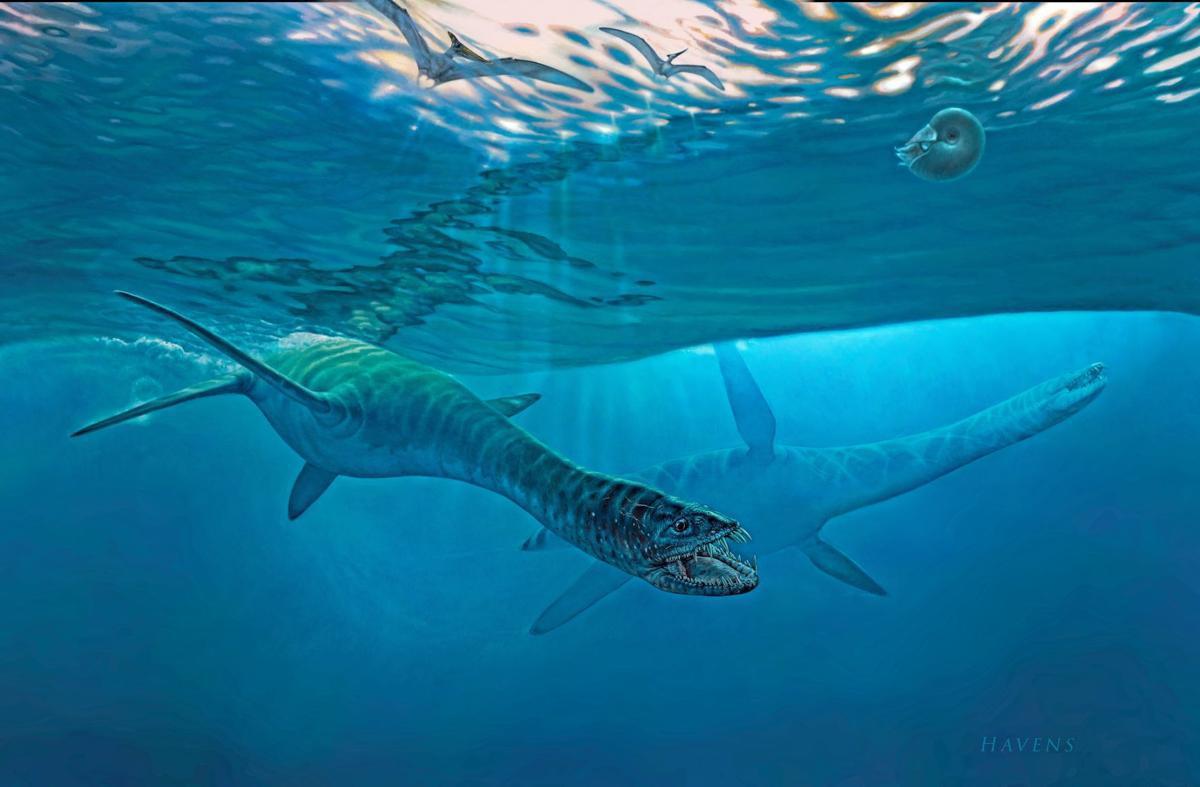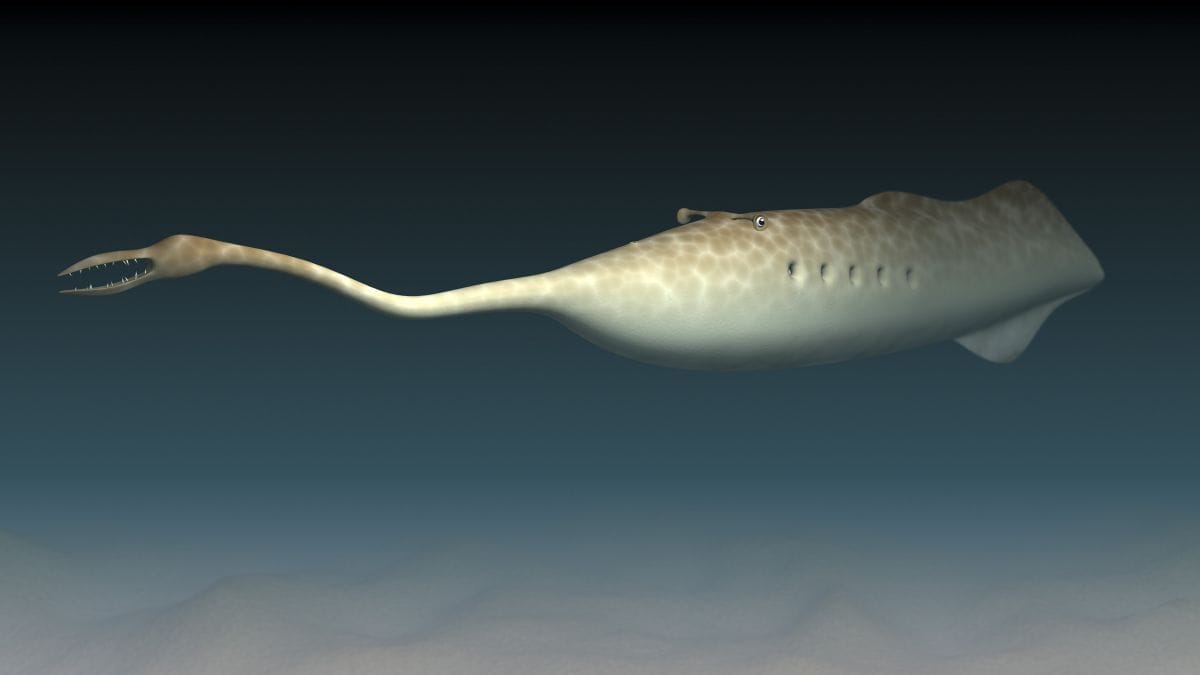About 506 million years ago, a strange sea creature swam in warm waters on the ocean floor off the coast of present-day Canada. At that point in time, it was one of Earth’s largest hunters.
Khoảng 506 triệu năm trước, một sinh vật biển kỳ lạ đã bơi trong vùng nước ấm dưới đáy đại dương ngoài khơi bờ biển Canada ngày nay. Vào thời điểm đó, nó là một trong những thợ săn lớn nhất Trái đất.
Titanokorys gainesi – or Titanokorys, for short – is an arthropod from the Cambrian geological period. Titanokorys lived during a time when much of present-day North America was below warm seas.
Titanokorys gainesi – hay viết tắt là Titanokorys – là một loài động vật chân đốt từ kỷ địa chất Cambri. Titanokorys sống trong thời kỳ mà phần lớn Bắc Mỹ ngày nay nằm dưới biển ấm.
On September 8, scientists announced the discovery of its fossils in the Canadian Rockies. The area where it was found is known to be rich in Cambrian fossils.
Vào ngày 8 tháng 9, các nhà khoa học đã công bố việc phát hiện ra hóa thạch của nó ở dãy núi đá Canada. Khu vực nơi nó được tìm thấy được biết là có nhiều hóa thạch kỷ Cambri.
The name Titanokorys means “titanic helmet” — and for good reason. Titanic means very large. Helmet is a hard hat you wear on your head. And this creature’s “helmet” or head shell made up about two-thirds of its 50-centimeter-long body.
Tên Titanokorys có nghĩa là ” titanic helmet ” – và vì lý do chính đáng. Titanic có nghĩa là rất lớn. helmet là một chiếc mũ cứng mà bạn đội trên đầu. Và “mũ bảo hiểm” hay vỏ đầu của sinh vật này chiếm khoảng 2/3 cơ thể dài 50 cm của nó.
While that may not sound very big, during the Cambrian Period it was huge.
Mặc dù điều đó nghe có vẻ không lớn lắm, nhưng trong Kỷ Cambri, nó rất lớn.
“Most other life forms were smaller than a human thumbnail at that time. By comparison, Titanokorys was longer than an adult human forearm,” said Jean-Bernard Caron. He is a paleontologist of the Royal Ontario Museum in Toronto. He is also the lead writer of the study that appeared in the publication Royal Society Open Science. He and his team spoke with Reuters news agency about their discovery.
Jean-Bernard Caron cho biết: “Hầu hết các dạng sống khác đều nhỏ hơn móng ngón tay cái của con người. So sánh, Titanokorys dài hơn cẳng tay người trưởng thành”, Jean-Bernard Caron cho biết. Ông là nhà cổ sinh vật học của Bảo tàng Hoàng gia Ontario ở Toronto. Ông cũng là tác giả chính của nghiên cứu xuất hiện trên ấn phẩm Khoa học mở của Hiệp hội Hoàng gia Anh và nhóm của mình đã nói chuyện với hãng tin Reuters về khám phá của họ.
Caron said in its day, Titanokorys was a “giant.” It was also a very strange looking animal. He added, “it could be compared to a giant swimming head since the body was so short …”
Caron cho biết vào thời của nó, Titanokorys là một “người khổng lồ”. Nó cũng là một con vật trông rất kỳ lạ. Anh ấy nói thêm, “nó có thể được so sánh với một cái đầu bơi khổng lồ vì cơ thể quá ngắn …”
The creature was also flat, so it could live on the sea floor.
Sinh vật này cũng phẳng, vì vậy nó có thể sống dưới đáy biển.
The eyes of the Titanokorys had many different moving parts. Its circular mouth was lined with triangular tooth-like structures. It had two claws to capture prey. It had gills and a series of flaps on the sides of its body for swimming.
Đôi mắt của Titanokorys có nhiều bộ phận chuyển động khác nhau. Miệng hình tròn của nó có cấu trúc giống như răng hình tam giác. Nó có hai móng vuốt để bắt con mồi. Nó có mang và một loạt cánh ở hai bên cơ thể để bơi.
Scientists think the Titanokorys fed on buried prey like worms. It used its claws to dig in the mud to find food. However, its claws did not pick up the prey; instead, they pulled the prey into the mouth.
Các nhà khoa học cho rằng Titanokorys ăn những con mồi bị chôn vùi như giun. Nó sử dụng móng vuốt của mình để đào trong bùn để tìm thức ăn. Tuy nhiên, móng vuốt của nó không gắp được con mồi; thay vào đó, chúng kéo con mồi vào miệng.
Joe Moysiuk is a paleontologist at the University of Toronto and the Royal Ontario Museum. He is also co-writer of the study. He told Reuters that when the fossils “were first discovered, they were so unusual looking” that the scientists were not sure what kind of animal they belonged to.
Joe Moysiuk là nhà cổ sinh vật học tại Đại học Toronto và Bảo tàng Hoàng gia Ontario. Ông cũng là đồng tác giả của nghiên cứu. Ông nói với Reuters rằng khi các hóa thạch “lần đầu tiên được phát hiện, chúng trông rất khác thường” đến nỗi các nhà khoa học không chắc chúng thuộc về loại động vật nào.
He added that because of their strange shape, scientists in the field call them “the mothership.” They use this description because the creature looks something like an unusual spaceship.
Ông nói thêm rằng vì hình dạng kỳ lạ của chúng, các nhà khoa học trong lĩnh vực này gọi chúng là “Tàu mẹ ”. Họ sử dụng mô tả này vì sinh vật trông giống như một con tàu vũ trụ bất thường.
The recent fossil discovery is not the first. Scientists discovered parts of fossils of many Titanokorys individuals in Canada’s British Columbia between 2014 and 2018.
Phát hiện hóa thạch gần đây không phải là lần đầu tiên. Các nhà khoa học đã phát hiện ra các phần hóa thạch của nhiều cá thể Titanokorys ở British Columbia của Canada từ năm 2014 đến năm 2018.
The Cambrian period
Kỷ Cambri
The Cambrian Period was from about 542 million to 488 million years ago. It was an important time in the history of life on Earth.
Kỷ Cambri có từ khoảng 542 triệu đến 488 triệu năm trước. Đó là một thời điểm quan trọng trong lịch sử sự sống trên Trái đất.
During the Cambrian Period, many major animal groups first appeared on Earth. Because such a great amount of life appeared in such a short amount of time, scientists call this time period “Cambrian Explosion.”
Trong kỷ Cambri, nhiều nhóm động vật chính lần đầu tiên xuất hiện trên Trái đất. Bởi vì một lượng lớn sự sống xuất hiện trong một khoảng thời gian ngắn như vậy, các nhà khoa học gọi khoảng thời gian này là “Vụ nổ kỷ Cambri”.
Nguồn : https://learningenglish.voanews.com/a/fossil-of-strange-sea-creature-discovered/6220400.html
Từ mới :
arthropod – [‘ɑ:θrəpɔd] n. (động vật học) động vật chân đốt
Nhện, kiến, ong và ong vò vẽ là 4 loài chân khớp thường cắn người nhất.
Spiders, ants, bees, and wasps are the four kinds of arthropod that most often bite people.
geological – [dʒiə’lɔdʒikəl] adj. (thuộc) địa chất
Đó là một bản khảo sát địa lý.
It is a geological survey.
fossil – [‘fɔsl] n. hoá thạch
dầu là một loại nhiên liệu hóa thạch.
oil is another fossil fuel.
paleontologist – [,peiliɔn’tɔlədʒist] n. nhà cổ sinh vật học
giant – [‘dʒaiənt] adj. khổng lồ
Anh ta đã trồng được một cái bắp cải khổng lồ.
He plant a giant cabbage.
claw – [klɔ:] n. vuốt (mèo, chim)
Con đại bàng quắp một con chuột trong móng vuốt của nó.
The eagle held a mouse in its claw.
prey – [prei] n. con mồi
gill – [dʒil] n. mang (cá)
flap – [flæp] n. vành (mũ); cánh (bàn gấp); vạt (áo); dái (tai) (something broad and flat or flexible that hangs loose)
Tôi đã nhét mép phong bì vào trong rồi.
I tucked the flap of my envelope in.
—
“The best time to plant a tree was 20 years ago. The second best time is now.” – Chinese Proverb


